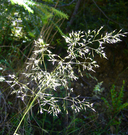Taxon Report
Calamagrostis bolanderi Thurb.Bolander's reed grass |
 ©2009 Zoya Akulova |
Taxon Summary
Calamagrostis bolanderi, commonly known as Bolander's reed grass, is a perennial rhizomatous herb in the Poaceae that is found only in California. It occurs within Bogs and fens, Broadleafed upland forest, Closed-cone coniferous forest, Coastal scrub, Marshes and swamps (freshwater), Meadows and seeps (mesic), and North Coast coniferous forest, growing at elevations from 0 to 455 meters. Calamagrostis bolanderi is ranked 4.2, Plants of Limited Distribution, A Watch List; Moderately threatened in California.Classification
|
Scientific Name: |
Calamagrostis bolanderi Thurb. |
|
Common Name: |
Bolander's reed grass |
| Family: | Poaceae |
| Element Code: | PMPOA17010 |
| USDA Plants Symbol: | CABO |
|
Synonyms/Other Names: |
|
Ecology and Life History
| Lifeform: | perennial rhizomatous herb |
| Blooming Period: May-Aug | May-Aug |
| Elevation: | 0-455 (0-1495) |
| General Habitats: | Bogs and fens, Broadleafed upland forest, Closed-cone coniferous forest, Coastal scrub, Marshes and swamps, Meadows and seeps, North Coast coniferous forest |
| Microhabitat: | Mesic |
| Microhabitat Details: |
Conservation Status
| CA Rare Plant Rank: | 4.2 |
| Global Rank: | G4 |
|
State Rank: |
S4 |
| State List: | None |
| Fed List: | None |
| Other Status: | |
|
CRPR Changes: |
|
Occurrence Data from the CNDDB
| Total Occurrences: | 0 |
| Element Occurrence Ranks: | |
| Excellent (A) | 0 |
| Good (B) | 0 |
| Fair (C) | 0 |
| Poor (D) | 0 |
| None (X) | 0 |
| Unknown (U) | 0 |
| California Endemic: True | |
| California Counties and Islands: Name (Code) | |
| Humboldt (HUM), Mendocino (MEN), Sonoma (SON) | |
| Quads: Name (Quad Code) | |
| Annapolis (3812363), Comptche (3912335), Crannell (4112411), Dutchmans Knoll (3912356), Elk (3912326), Eureka Hill (3812385), Fort Bragg (3912347), Gualala (3812375), Hales Grove (3912377), Inglenook (3912357), Mallo Pass Creek (3912316), Mathison Peak (3912336), Mendocino (3912337), Navarro (3912325), Northspur (3912345), Noyo Hill (3912346), Piercy (3912387), Plantation (3812353), Point Arena (3812386), Rodgers Peak (4112421), Saunders Reef (3812376), Sebastopol (3812247), Sherwood Peak (3912355), Stewarts Point (3812364), Trinidad (4112412), Two Rock (3812237) | |
Threat List Data from the CNDDB
| Threat List Total: | 0 | |
| EOs with Threat Listed: | Total EOs | % of EOs |
| 0 | 0 % | |
Selected References
| Proposed Change from CRPR 1B, G2 / S2.2 to 4, G3 / S3.2 (2003) |
Citation
California Native Plant Society, Rare Plant Program. 2025. Rare Plant Inventory (online edition, v9.5.1). Website https://www.rareplants.cnps.org [accessed 8 December 2025].